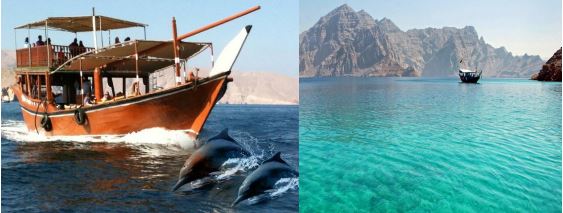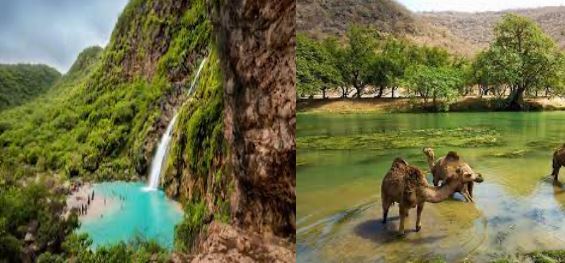

There is an abundance of choices for visitors, from world-class shows at the Royal Opera House Muscat to fine dining at one of the many restaurants scattered across the capital or shopping for traditional souvenirs at Muttrah Souq, one of the oldest in Arabia. Museums, such as the Children’s Museum, Natural History Museum, National Museum of Bait Al Zubair, welcome those who wish to delve deeper into the Sultanate’s rich natural and cultural history. For art lovers, several galleries are showcasing modern Omani art. As for activities, the capital region has almost endless possibilities. Whether snorkeling at the Daymaniyat Islands, trekking from Old Muscat to Muttrah, a guided city tour, or a day trip to a nearby wadi, Muscat welcomes all to experience its unique charm.

Some of Oman’s most significant attractions are in this region, including the Sultanate’s highest mountain – Jebel Shams – and Jebel Al Akhdar, a mountainous plateau known for its green terrace fields brimming with roses, pomegranates, and other fruit. The Al Hoota Caves, a recently-restored vast cave system estimated to be over two million years old and rich with stalactites and stalagmites, and many ancient castles and forts which have also been beautifully restored and are now open to the public are also of interest, especially UNESCO World Heritage Sites the Bahla Fort and the renowned Nizwa Fort and Souq.

A'Sharqiyah Sands is considered among the most beautiful camping areas in the Sultanate and extends over up to about 10 thousand square kilometers. The Sand colors range from red to brown as far as the eye can see. It is the original homeland of the Bedouins. This area attracts many desert adventure fans and is preferred by visitors owing to its ease of accessibility and availability of nearby services, making it a first-class tourist attraction. Also, tourist camps that make the sands their home base offer various services in this sea of golden sand and have played an essential role in promoting A'Sharqiyah Sands. Wilayat Badiyah is a beautiful oasis located at the entrance of A'Sharqiyah Sands. It is considered a starting point to explore the depths of the sand and enter into a world full of excitement and vitality, away from the bustle of the city and a change from daily routines. These sands embrace many oases. For example, Al Raka Oasis, which is surrounded by dunes on three sides and forms a spectacular landscape, and Shahik Oasis and Al Hawiyah Oasis, the largest oasis, contains several trees and is surrounded by dunes that form a splendid scene. Al Hawiyah Oasis is considered a vivid example of this unique mixture, for it is embraced by the golden sands to create a peninsula of greenery, putting it on a pedestal of its own compared with other oases in the Sultanate. The sharp sandy slopes in the southern part of this oasis are one of the most beautiful sites for sand skiing. Al Aidan Oasis is so called from the shady leafy trees and a water well on this site. Accessing this oasis requires the help of a guide. Many tourist activities take place on these sands, such as sandduring in four-wheel-drive dune buggies, as well as horse and camel racing.

Consisting of the governorates of North and South Ash Sharqiyah, this part of Oman is widely considered the geographical jewel of the Sultanate. Here, stunning coastlines give way to the unique ecosystem that is Sharqiyah Sands, making this region a paradise for adventurers and explorers. The South A’Sharqiyah Governorate is the north-eastern facade of the Sultanate of Oman. It overlooks the Arabian Sea from the east and is connected to the Sharqiyah sands from the south and Al-Dakhiliyah Governorate from the west. South A’Sharqiyah governorate includes five districts: Sur, Al-Kamel Wa Al-Wafi, Jalan Bani Bu Hassan, Jalan Bani Bu Ali, and Masirah Island. The white sand and pebble beach found between Wadi Shab and Wadi Tiwi are great for water enthusiasts. The city of Sur, famed for its shipbuilding, makes for fantastic camping and fishing locations. It should also come as no surprise that this area offers a tremendous range of activities for nature and sea lovers; from turtle watching at Ras Al Hadd to kite surfing on Masirah Island or visiting the traditional Dhow yard of Sur, where Arabia’s ancient style of boat continues to be crafted by hand.

The exclave of Musandam is Oman’s northernmost governorate, separated from the rest of Oman by the UAE and home to some of the Sultanate’s most dramatic landscape. Here, The 2000m high mountains meet the sea with stunning fjords and crystal-clear waters, making this area one of the world's best diving and snorkeling spots. The city of Khasab makes a great base from which to explore the Musandam Peninsula, where you can enjoy the scenery from on the water, starting with a cruise on a traditional Dhow to spot pods of dolphin resting and feeding and continuing with a trip to the surrounding mountains and fjords by 4WD vehicle or mountain bike if you’re feeling extra adventurous. The village of Kumzar is accessible only by boat and requires an invitation from a local. Alternatively, boat trips to Telegraph Island or Khawr Najd make for an unforgettable one or two-day excursion.

Although Dhofar lies over 1,000 kilometers from the capital city of Muscat, planning a trip is accessible with daily flights between Muscat and Salalah and direct connections from other Arab Gulf states. Those with some spare time may also opt to drive the coastal road to Salalah, traversing through Al Wusta and seeing some of Oman’s most remote yet breathtaking beaches. Oman’s southernmost region is host to many unique attractions, including Prophet Ayoub’s Grave nestled deep in the mountains, the blowholes of Mughsayl, and the Land of Frankincense – a UNESCO World Heritage Site. Deep-sea diving and snorkeling off the coast of the Hallaniyat Islands are just some of the more adventurous activities available through local tour operators. In the summer months, when most of the Arabian Peninsula experiences soaring temperatures, Dhofar ushers in the monsoon season, bringing its lush greenery, cooling rains, and pleasant temperatures. Locally known as Khareef, this particular season starts from late June to early September and coincides with the Salalah Tourism Festival, held every year.
We accept: VISA, MASTERCARD, & CASH. In addition we accept pre-established credit approved accounts by the Hotel to charge back.
![]()